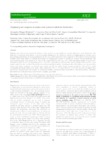Please use this identifier to cite or link to this item:
http://www.alice.cnptia.embrapa.br/alice/handle/doc/1067721Full metadata record
| DC Field | Value | Language |
|---|---|---|
| dc.contributor.author | BRIGHENTI, A. M. | pt_BR |
| dc.contributor.author | LEDO, F. J. da S. | pt_BR |
| dc.contributor.author | MACHADO, J. C. | pt_BR |
| dc.contributor.author | VAROTTO, Y. V. G. | pt_BR |
| dc.date.accessioned | 2017-03-27T11:11:11Z | pt_BR |
| dc.date.available | 2017-03-27T11:11:11Z | pt_BR |
| dc.date.created | 2017-03-27 | pt_BR |
| dc.date.issued | 2017 | pt_BR |
| dc.identifier.citation | Australian Journal of Crop Science, v. 11, n. 1, p. 38-42, 2017. | pt_BR |
| dc.identifier.uri | http://www.alice.cnptia.embrapa.br/alice/handle/doc/1067721 | pt_BR |
| dc.description | Abstract Elephant grass (Pennisetum purpureum Schum.) fodder productivity and quality are directly affected by weed interference. The difficulty in controlling weed species is one of the major limitations to the production and use of elephant grass as a forage crop in dairy farming and biomass for energy production. In this study, field experiments were conducted in 2014 and 2015 at two locations in Minas Gerais State, Brazil, to evaluate the tolerance of elephant grass pasture to acetolactate synthase inhibitor herbicides. The experimental pastures were treated at 1× and 2× the normal field-use rates (g ai ha-1) with metsulfuron-methyl (7.8 and 15.6), chlorimuron-ethyl (15 and 30), halosulfuron (112.5 and 225), ethoxysulfuron (150 and 300), and nicosulfuron (60 and 120). A nontreated control was also included. The results showed that metsulfuron-methyl, chlorimuron-ethyl, halosulfuron, and ethoxysulfuron caused mild injury symptoms on elephant grass plants, but did not reduce forage biomass production. Nicosulfuron caused considerable percentage injury to the plants, which varied from 53% to 73% and from 65% to 83% for the lower and higher rates, respectively. Elephant grass was tolerant of metsulfuron-methyl, chlorimuron-ethyl, halosulfuron, and ethoxysulfuron. Therefore, these herbicides could potentially control weeds in elephant grass fields. | pt_BR |
| dc.language.iso | eng | eng |
| dc.rights | openAccess | eng |
| dc.subject | Napier grass | pt_BR |
| dc.subject | Selectivity | pt_BR |
| dc.subject | Tolerance | pt_BR |
| dc.title | Elephant grass response to amino-acid synthesis inhibitor herbicides. | pt_BR |
| dc.type | Artigo de periódico | pt_BR |
| dc.date.updated | 2017-07-07T11:11:11Z | pt_BR |
| dc.subject.thesagro | Pennisetum Purpureum | pt_BR |
| dc.subject.nalthesaurus | forage | pt_BR |
| riaa.ainfo.id | 1067721 | pt_BR |
| riaa.ainfo.lastupdate | 2017-07-07 | pt_BR |
| dc.contributor.institution | ALEXANDRE MAGNO B DOS SANTOS, CNPGL; FRANCISCO JOSE DA SILVA LEDO, CNPGL; JUAREZ CAMPOLINA MACHADO, CNPGL; Yago Vieira Guerra Varotto, CES JF. | pt_BR |
| Appears in Collections: | Artigo em periódico indexado (CNPGL)  | |
Files in This Item:
| File | Description | Size | Format | |
|---|---|---|---|---|
| Cnpgl2016AustJCropSciElephant.pdf | 389,66 kB | Adobe PDF |  View/Open |









